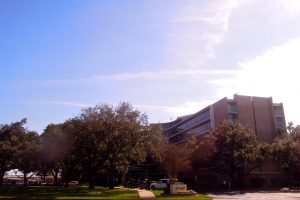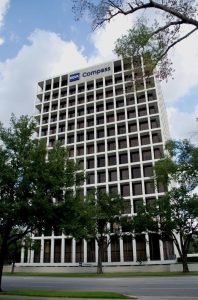Wilson, Morris, Crain and Anderson
Seth Irwin “S.I.” Morris and his former Rice classmate F. Talbott Wilson, Jr. were the original founders of the firm. At the end of the New Deal era in the 1940s, the partners earned a major early commission: Park Lane Apartments on Hermann Drive which was Houston’s most impressive Federal Housing Administration-sponsored garden apartment complex. At about the same time, developer E.L. Crain hired the young architects to design a series of houses in his new Garden Oaks subdivision, and helped them win the contract to design the Garden Oaks School. After wartime service with the U.S. Navy, Morris returned to Houston and re-established his practice with Wilson. In 1946, a third partner, B.W. Crain, Jr. joined the firm. In 1953, Ralph Anderson, Jr. became the fourth partner.
Wilson, Morris, Crain & Anderson was selected as associate architect with Skidmore, Owings & Merrill for the First City National Bank Building in 1961 and received the federal commission for the new U.S. Post Office in 1962.
The firm’s greatest challenge and greatest triumph came when Judge Roy Hofheinz chose Wilson, Morris, Crain & Anderson to design the Harris County Domed Stadium (1965) with Lloyd, Morgan & Jones. After the Astrodome, the firm made its biggest impact on Houston’s skyline in the 1970s when it designed Gerald Hines’ first major downtown office building, One Shell Plaza (1971), again with Skidmore, Owings & Merrill. The firm was soon commissioned to design One Allen Center (1972) on its own.
In 1970, Morris recruited Eugene Aubry as chief designer and two years later the firm dissolved, with Morris establishing S.I. Morris Associates, and Wilson/Crain/Anderson continuing separately with offices in Houston and Longview.
—
Talbott Wilson, FAIA was principal architect for the Main Houston Post Office, Houston Light and Power Building, SW Bell Headquarters, Astrodome (with Lloyd, Morgan and Jones), River Oaks Bank & Trust, buildings at Rice University, St. Philip Presbyterian, Central Presbyterian (demolished), Style and Steel Townhouses, and many other residential, commercial and institutional projects.
Ralph Anderson, FAIA was principal architect for Kelsey Seybold Clinic (demolished), Houston Post, Mavis Kelsey Residence (demolished) and many other residential, commercial and institutional projects.


